Vintage Treasures: The Plenty Trilogy by Colin Greenland
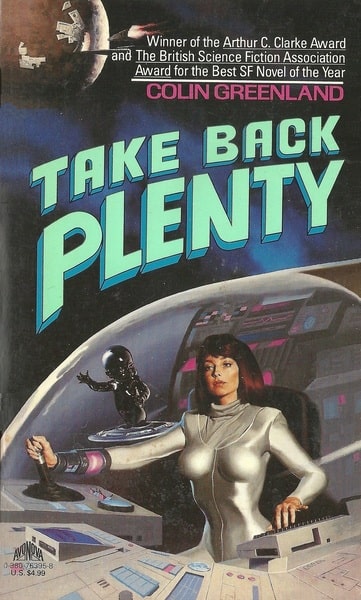 |
 |
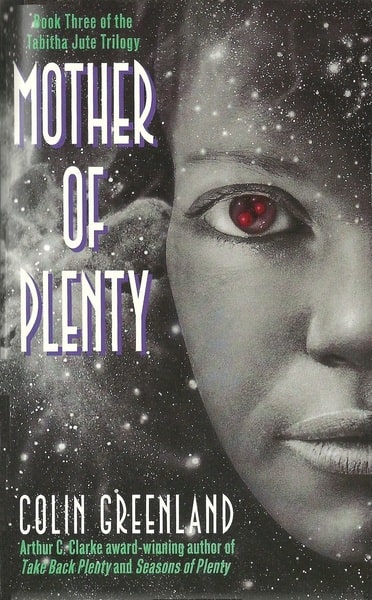 |
Take Back Plenty, Seasons of Plenty, and Mother of Plenty (AvoNova, January 1992 and
January 1996, and Avon Eos, June 1998). Covers by Glenn Orbik, Jim Burns, and uncredited
Colin Greenland’s Take Back Plenty was one of the major British SF novels of the 90s. It won the British Science Fiction Award and the Clarke Award for Best SF Novel, and was nominated for the Philip K. Dick Award. Writing about its heroine, Tabitha Jute, in Science Fiction: The Illustrated Encyclopedia, John Clute said:
Colin Greenland, one of the sharpest and most innovative young British critics and novelists, had a bright idea. The old SF was joyous. So why not enjoy it, even now? Why not write Space Opera whose heroine – Tabitha Jute – may not change the universe, but who is superabundantly alive? So he did.
Greenland followed Take Back Plenty with two sequels, Seasons of Plenty, and Mother of Plenty, and one collection, The Plenty Principle, which included a prequel tale using the same setting, a derelict planet-sized starship “populated by gamblers, militarists, and space trash” known as Plenty.
[Click the images for versions that are Plenty bigger.]
 |
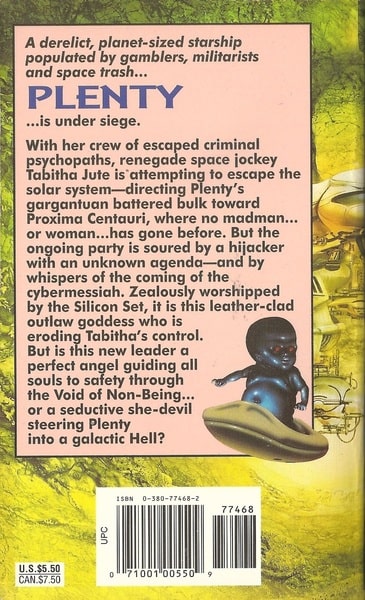 |
 |
Back covers to Take Back Plenty, Seasons of Plenty, and Mother of Plenty
Take Back Plenty was originally published as a paperback original by Unwin Paperbacks in the UK in 1990 (and reprinted by Grafton in 1991). It didn’t see a US edition from AvoNova until January 1992. It first appeared in hardcover from the Science Fiction Book Club in June 1992.
Unlike US publishers, Unwin and Grafton had no problem depicting Captain Tabitha Jute as Black. Thirty years ago however, US publishers had no appetite for putting Black protagonists on covers, and so Tabitha Jute was unapologetically whitewashed. Both the AvoNova cover (by Glenn Orbik) and the SFBC edition (art by Walter Velez, below) depicted her as a white supermodel.
Science Fiction Book Club edition of Take Back Plenty
(June 1992), with a white Tabitha Jute. Cover by Walter Velez
The sequels, Seasons of Plenty and Mother of Plenty, were published in the UK by Voyager/HarperCollins with gorgeous wraparound covers by Jim Burns, with more authentic (and far more interesting) depictions of Captain Jute.
For whatever reason, AvoNova elected to reuse the Jim Burns artwork for the US release of Seasons of Plenty, correcting the egregious error they’d made with the first book. They declined to use the Burns cover for Mother of Plenty, but at least they gave us a Black Captain Jute on the cover, so I suppose that’s something.
Below are the Jim Burns wraparound covers for the HarperCollins UK editions.
HarperCollins hardcover edition of Seasons of Plenty (June 1995). Cover by Jim Burns
Voyager/HarperCollins UK paperback edition of Mother of Plenty (July 1998). Cover by Jim Burns
And here’s a look at the gorgeous original artwork for both.
(Click the images to see larger versions.)
Jim Burns’ original art for Seasons of Plenty
Jim Burns art for Mother of Plenty. Note the back cover was re-used for The Plenty Principle
I first heard about Take Back Plenty in a review in Science Fiction Eye, one of the better SF review zines of the 90s. Here’s a snippet from Sherry Coldsmith’s excellent coverage, from the Winter ’91 issue:
Take Back Plenty is a raid on the traditional space opera, a coup at the galactic palace. Its author has poked through the rubble of pulp SF, looking for the genre’s mermaids and Marie Celestes. Greenland’s pickings include a fecund Venus that chokes with unconquerable jungles, and an arid Mars scarred by canals. More modern tropes are also put to use: cyberjacks, talking corpses, titanic tin-can inhabitants that circle the Earth. Greenland has chucked away anything that requires scientific veracity and kept anything that possess mythic dazzle.
The protagonists are as fascinating as the background. Tabitha Jute is the owner-operator of a space vehicle, the sentient and personable Alice Liddell. These two soul sisters of the Sol system get into love and trouble in a world that Is a surreally logical as the one the bedeviled Lewis Carroll’s Alice.
Take Back Plenty was widely acclaimed when it first appeared, especially across the pond. The London Times called it “A K.O.!.. one of the most compulsive space spectaculars in years,” and Analog proclaimed it, “A fun tale… a wild ride through a strange universe.”
Much of the praise for the book centered in its quirky and likable heroine. Writing in David Hartwell’s The New York Review of Science Fiction, Gwyneth Jones summarized her as,
Tabitha Jute… a cussed cantankerous, self-centered Han Solo — who saves the world regularly, pulls all the sexy guys, and still ends up alone in the launderette of life, watching her socks go round.
In 2013, Take Back Plenty was reissued as part of the Gollancz SF Masterworks line, with a sharp-looking cover by Chris Moore.
Take Back Plenty (Gollancz SF Masterworks, 2013). Cover by Chris Moore
Martin Lewis published a fine review of Take Back Plenty at my old website, SF Site, in 2002. Here’s an excerpt.
The Plenty of the title is a gigantic space station built by an alien race called the Frasque. The Frasque have long since been forcibly evicted by another race, the Capellans, and their bureaucrats-cum-enforcers, the Eladeldi. The Capellans, with their superior technology, have set themselves up as benevolent hands-off dictators of the Solar system.
Tabitha Jute is a blue-collar pilot who has had the good fortune to acquire her own ship, the Alice Liddell. She is also in dire need of cash to pay off fines and get some urgent repairs. In order to do so she takes on a delivery job from a musician she has a fling with called Marco Metz… On Plenty they meet up with the rest of Marco’s band (called — nudge nudge, wink wink — Contraband) which is made up of male and female twins who are seemingly identical and a Cherub, a type of post-human that resembles a glossy black baby on a flying saucer. Due to Marco’s machinations, they are forced to leave Plenty rather hastily and from then on they hardly stop moving.
Like David Brin’s Uplift series, this is a modern space opera that harkens back to the old school. It is a high action romp packed with exotic aliens that is not overly concerned with the underlying mechanics of its universe. As John Clute has noted, space operas tend to stick to the set piece and Take Back Plenty is no exception. Virtually every chapter details them getting into or getting out of a sticky situation…
Take Back Plenty was published to widespread critical acclaim and it went on to win major awards.. The most impressive aspect of book is probably the realism with which Colin Greenland portrays his heroine. In contrast to the ultra-competent pilots of most space yarns, Tabitha remains reassuringly normal. She gets drunk, passes out and wakes, hung over, in police cells. She sulks and letches shamelessly, whilst all the time dragging around a handbag full of crap.
The relationship between Tabitha and her ship Alice is also especially well-realised. Greenland perfectly captures their unusual and touching relationship and his depiction of Alice as a melange of mother, sister and daughter is a highly memorable evocation of an artificial personality… What we have here is full-blooded entertainment that effortlessly side steps the usual pitfalls of this breed of fiction and you can’t say fairer than that.
Read the whole thing here.
 |
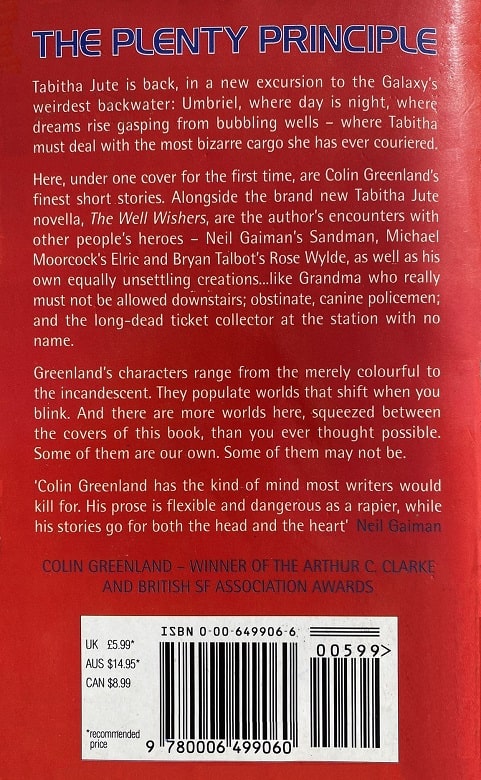 |
The Plenty Principle (Voyager/HarperCollins, March 1997). Cover by Jim Burns
In 1997 Greenland and HarperCollins released The Plenty Principle, which collected 19 stories, each with a brief introduction by the author. Two of the tales featured Tabitha Jute, including a prequel tale “In the Garden: The Secret Origin of the Zodiac Twins,” and the 63-page novella, “The Well Wishers,” original to this volume.
It also included the short story “The Suffer the Children Man,” which was broadcast on BBC Radio 4 on November 3, 1995; the Sandman story “Masquerade and High Water” (originally published in The Sandman: Book of Dreams, 1996), the Elric tale “Temptations of Iron” (from Michael Moorcock’s Elric: Tales of the White Wolf, 1994), and five originals: “Talking Through the Wind,” “Them That’s Got,” “A Bunch of Wild Roses,” “The Suffer the Children Man,” and “The Well Wishers.”
The Plenty Principle was never released in the US, but copies aren’t hard to find online. I bought the copied I scanned above for $5.41 (including shipping) on eBay in December.
Here’s the complete Table of Contents for The Plenty Principle.
“The Traveller” (Zenith: The Best in New British Science Fiction, 1989)
“The Station with No Name” (Thirteen More Tales of Horror, 1994)
“Grandma” (13 Again, 1995)
“A Passion for Lord Pierrot” (Zenith 2: The Best in New British Science Fiction, 1990)
“Miss Otis Regrets” (1982)
“The Suffer the Children Man” (1995)
“Talking Through the Wind”
“Them That’s Got”
“The Wish” (Other Edens II, 1988)
“Station of the Cross” (Tombs, 1995)
“Candy Comes Back” (In Dreams, 1992)
“Masquerade and High Water” (The Sandman: Book of Dreams, 1996)
“The Travelling Companion” (Strange Plasma #8, 1994, 1994)
“Temptations of Iron” (Michael Moorcock’s Elric: Tales of the White Wolf, 1994)
“A Bunch of Wild Roses”
“Going to the Black Bear” (The Weerde: Book 1, 1992)
“Nothing Special” (Temps, 1991)
“In the Garden” (In the Garden: The Secret Origin of the Zodiac Twins, 1991)
“The Well Wishers”
Here’s the complete publishing details for the Plenty trilogy, plus The Plenty Principle.
Take Back Plenty (AvoNova, 484 pages, $4.99 in paperback, January 1992) — cover by Glenn Orbik
Seasons of Plenty (AvoNova, 422 pages, $5.50 in paperback, January 1996) — cover by Jim Burns
Mother of Plenty (Avon Eos, 470 pages, $5.99 in paperback, June 1998) — cover uncredited
The Plenty Principle (Voyager/HarperCollins, 427 pages, £5.99 in paperback, March 1997) — cover by Jim Burns
Our previous coverage of the series includes a Vintage Treasures piece on Take Back Plenty from 2018:
See all our recent Vintage Treasures here.
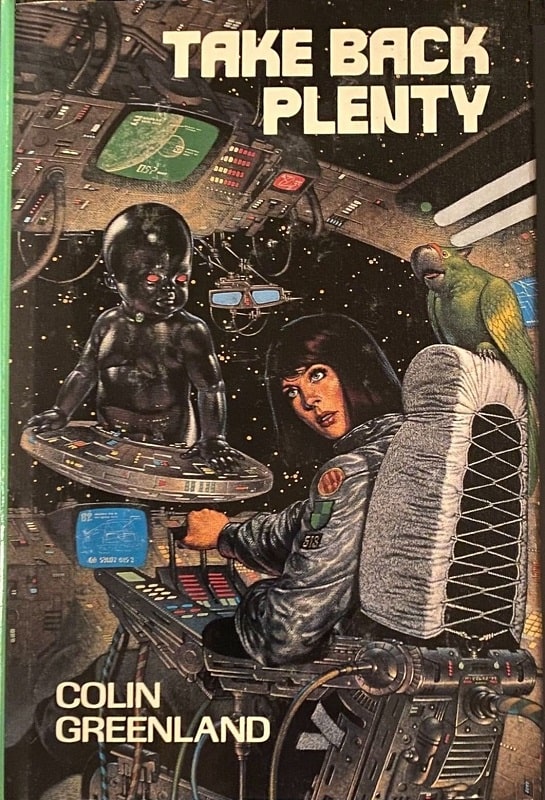

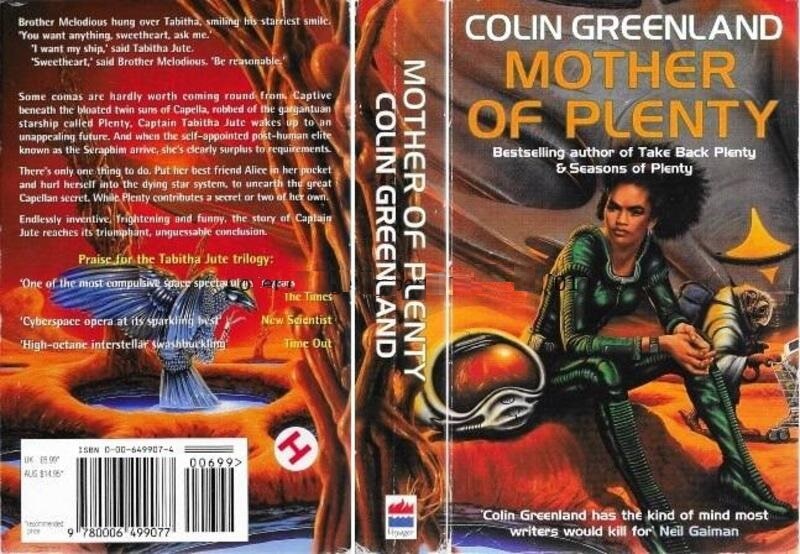

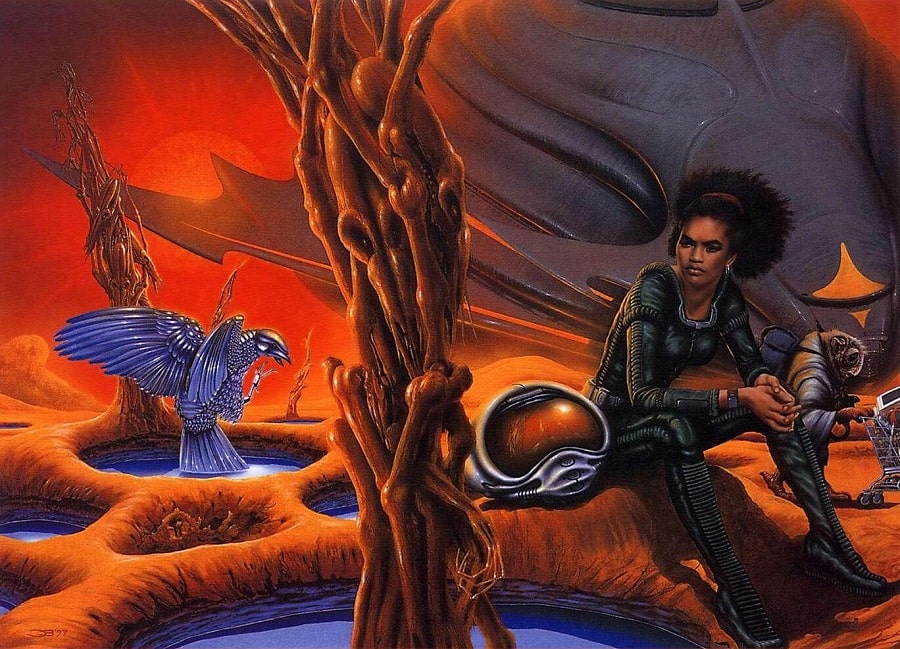

I don’t remember these books. The AvoNova paperback cover for Take Back Plenty looks familiar, so I probably saw it at the book store, but that’s probably about it. But I’ve remedied this by picking them up off of eBay and should have them in about a week.
Some US publishers did put black protagonists on their covers. The best examples I can think of are Tor’s reprint of Steven Barne’s Streetlethal and both the Dell and Berkley editions of F.M. Busby’s Zelda M’Tana. Also, DAW Books editions of Charles Saunder’s Imaro books come to mind.
John, thanks for a great post on a great book. I am pretty sure I owned the first US paperback of “Take Back Plenty” at one time. It is currently listed in my Book Database as “not found”, which was my experience when looking as well. I am chagrined that I did not notice this whitewashing. I attribute this to my white privilege and to not really paying attention to covers. I don’t think I ever read the other books; if I did, it predated my book database.